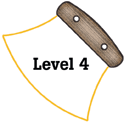
Alaska Science
Key Element A6
 |
Alaska Science |
|
Performance Standard Level 4, Ages 15–18
|
|
|
|
Sample Assessment Ideas
|
|
|
Expanded Sample Assessment Idea
|
|
Procedure Students will:
Reflection and Revision
|
Levels of Performance |
||
|
Stage 4 |
Student work is complete, correct and shows detailed evidence of the transfer and extension of knowledge that relates forces to motion. Each section of the lab report is detailed and shows evidence of logical reasoning. Calculations are accurate; graphs are correctly labeled and accurately represent the observations; error analysis contains detailed discussion of each source of error; experimental results are interpreted according to Newton’s Laws of Motion as well as coefficient of friction and the Applications section includes a thorough discussion of how Newton’s Laws of Motion apply to daily living or a local activity. | ||
|
Stage 3
|
Student work is mostly complete and shows evidence of the transfer or extension of knowledge that relates forces and motion. Most sections of the lab report shows evidence of logical reasoning, although some sections may contain minor errors or omissions. Calculations are mostly accurate; graphs are labeled and represent the observations; error analysis contains a discussion of sources of error; experimental results are interpreted according to Newton’s Laws of Motion or coefficient of friction; and the applications section includes a discussion of how Newton’s Laws of Motion apply to daily living or local activity | ||
|
Stage 2
|
Student work may be incomplete and shows limited evidence of knowledge of forces or motion. The lab report may include a preliminary or first draft attempt on the required sections though it contains errors of science fact and reasoning. | ||
|
Stage 1
|
Student work is mostly incomplete and shows misconceptions relating forces and motion. | ||
Standards Cross-References
|
||
|
National Science Education Standards Objects change their motion only when a net force is applied. Laws of motion are used to calculate precisely the effects of forces on the motion of objects. The magnitude of the change in motion can be calculated using the relationship F=ma, which is independent of the nature of the force. Whenever one object exerts force on another, a force equal in magnitude and opposite in direction is exerted on the first object. (Page 179) Waves, including sound and seismic waves, waves on water, and light waves, have energy and can transfer energy when they interact with matter. (Page 180) |
Benchmarks The change in motion of an object is proportional to the applied force and inversely proportional to the mass. (Page 91) All motion is relative to whatever frame of reference is chosen, for there is no motionless frame from which to judge all motion. (Page 91) Accelerating electric charges produce electromagnetic waves around them. A great variety of radiations are electromagnetic waves: radio waves, microwaves, radiant heat, visible light, ultraviolet radiation, x rays, and gamma rays. These wavelengths vary from radio waves, the longest, to gamma rays, the shortest. In empty space, all electromagnetic waves move at the same speed—the “speed of light.” (Page 92) Whenever one thing exerts a force on another, an equal amount of force is exerted back on it. (Page 92) The observed wavelength of a wave depends upon the relative motion of the source and the observer. If either is moving toward the other, the observed wavelength is shorter; if either is moving away, the wavelength is longer. Because the light seen from almost all distant galaxies has longer wavelengths than comparable light here on Earth, astronomers believe that the whole universe is expanding. (Page 92) Waves can superpose on one another, bend around corners, reflect off surfaces, be absorbed by materials they enter, and change direction when entering a new material. All these effects vary with wavelength. The energy of waves (like any form of energy) can be changed into other forms of energy. (Page 92) |
|
Table of Contents | Return to Alaska Native Knowledge Network